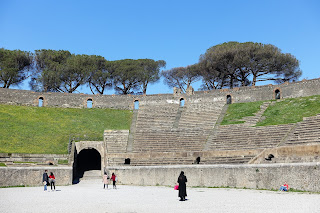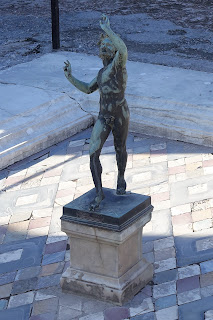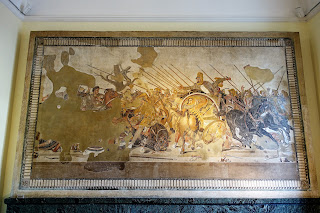A cast of one of the unfortunate victims of the CE 79 eruption
Decades ago, when I was in college, I took a class on Pompeii that went towards satisfying my general education requirements. The idea behind the course was to present the everyday lives of Roman citizens as reconstructed from what was unearthed in the ruins of Pompeii and Herculaneum, the two locales wiped out by the eruption of Mount Vesuvius in CE 79, using slides taken onsite by the history professor. While he wasn't the most dynamic of lecturers, the professor's enthusiasm for the subject was contagious, and I made it a personal goal to see Pompeii for myself one of these days. That day came on the first day of the Lunar New Year when my family and I took the Circumvesuviana train (through some of the worst graffiti-covered stations imaginable) to Pompeii Scavi-Villa dei Misteri, roughly 35 minutes from Naples and a short walk to the Porta Marina entrance.
Although we didn't purchase tickets online beforehand, the lines to enter the ruins were short and we were soon face-to-face with the Terme Suburbane, a public bathhouse decorated with erotic frescoes; unfortunately, it was closed on the Friday we visited:
My daughter stands in front of the Porto Marina, one of Pompeii's seven gates:
Vesuvius, the mountain that brought so much death and destruction, looms over the ruins:
We proceeded along the Via Marina, stopping to have a look at the remains of Pompeii's 2nd-century-BCE basilica, site of the city's law courts and exchange:
The foro (forum), the city's main piazza, flanked by limestone columns:
The site is huge, and it's impossible to see everything in the course of a single day. Many visitors were part of tour groups or had employed the services of guides, a good idea as detailed signage of what you're seeing is insufficient. On the other hand, just walking around aimlessly and popping in and out of the ruined homes, shops and bathhouses was enjoyable in itself (plus my wife had picked up a small guidebook in Mandarin at the visitor center that gave details of some of the buildings):
In the southern part of the complex stands the 5000-seat Teatro Grande, dating from the 2nd-century-BCE:
Hailing Caesar:
Pink Floyd recorded at this very amphitheater in October 1971, and an onsite display shows photographs and video of the event. For some reason, instead of capturing a shot of the band in action, I only managed to take a photo of Roger Waters telling David Gilmour and Rick Wright how good the oysters were:
Walking through the necropolis:
The most gruesomely fascinating sights at Pompeii are those of the body casts, made in the 19th century by pouring plaster into the hollows left by disintegrating bodies. They provide a snapshot of the final moments of those who didn't get out of the city in time, killed by the ash and pyroclastic flows that devastated Pompeii. It must've been a horrible way to die:
Sadly, many of the victims were children:
Looking out over what would've been rooftops 1939 years ago:
One of the most popular sights at Pompeii is the Lupanare, the ruins of a brothel with its, ahem, informative frescoes. I told Amber she could go inside to have a look if she wanted, but she declined the offer. Western society unfortunately became a lot more prudish once Christianity took hold and the Roman Empire declined. A pity:
Back at the forum, where the Granai del Foro (Forum Granary) displays more body casts, as well as hundreds of amphorae (tall ancient Roman jars or jugs with two handles and a narrow neck):
A famous cast of a dog caught in its death throes:
Following lunch (a tip: bring your own food, as the fare on offer in the cafeteria to the north of the forum isn't very enticing), we explored the Casa del Fauno, Pompeii's largest house. Many of the mosaics uncovered here are now displayed at Naples' Museo Archeologico Nazionale, which we would visit the next day:
Shu-E took a break, while Amber and I headed downhill to the Villa dei Misteri, the best-preserved villa at Pompeii:
The villa houses the Dionysiac frieze, the most important fresco remaining onsite:
Continuing our explorations of the streets:
The Anfiteatro is the oldest known Roman amphitheater in existence:
What remains of the Tempio di Apollo, the oldest and most important of the city's religious buildings:
Looking southwest from the ruins, in the opposite direction from Mount Vesuvius:
The last stop we made before exiting the ruins was at the visitor center:
It was a wait for me of around thirty years (!), but the ruins of ancient Pompeii delivered. One of the most impressive sights I've ever seen.
Back in Naples, Shu-E retired to our room for a rest while Amber and I had dinner at a small restaurant next to our hotel, ordering what else but pizza, Neapolitan-style. My daughter polished off hers before I was halfway done with mine:
Saturday was our last full day in Italy. We debated going to Herculaneum, a smaller city also devastated by Mount Vesuvius in the same eruption that brought belated fame to Pompeii, but opted instead to take the subway into Naples to visit the aforementioned Museo Archeologico Nazionale, the city's premier museum, showcasing (according to my guidebook) "one of the world's finest collections of Greco-Roman artefacts." The museum was established by King Charles VII in the late 18th century to house the antiquities he inherited from his mother, as well as artefacts taken from Pompeii and Herculaneum:
Amber pauses in the Entrance Hall:
The massive Hall of the Sundial on the top floor:
Flora, the "force behind everything that flowers":
The Portrait of Paquius Proculo, one of the most well-known of the frescoes recovered from Pompeii:
Sappho:
Naples as seen from a museum window:
Blue vase:
Statues of runners:
From Pompeii's Casa del Fauno comes the Dancing Faun...:
...and the Alexander Mosaic:
The amusingly-named Secret Room contains more examples of Roman erotic imagery, though the statue of Pan raping a she-goat is one of the most disturbing works of art ever created. My daughter again opted to wait outside; her mother, on the other hand, spent a surprisingly long time inside checking out the exhibits:
The late 1st-century BCE Aphrodite Kallipygos:
Canopic jars in the Egyptian Collection:
The most impressive sculpture in the collection is undoubtedly the Toro Farnese (Farnese Bull), created in the 2nd-century BCE:
Nearby stands the Farnese Hercules:
And so, after taking in the ruins of Pompeii and the jaw-dropping exhibits in the Museo Archeologico Nazionale, it was time to bid farewell to Naples. But not before one more gelato at a streetside cafe:
The gritty streets of Naples, a world away from the chic areas of Rome:
Ravioli for lunch at a ristorante in front of Napoli Centrale:
A last glimpse of Vesuvius on the high speed train heading back to Rome:
From Roma Termini we took the Leonardo express for the 32-minute journey to Leonardo da Vinci Airport, where we checked into the Hilton Rome Airport for our last night in the country (we had a 7:00 am flight for Frankfurt scheduled for Sunday morning):
And that was our all-too-brief sojourn to Italy, a fantastic country boasting an incredible array of artistic and historic sights. This was, in all probability, our last extended trip before we leave Vilnius in late June. In the nearly two years we've been here in Lithuania, we have traveled to Germany, the Netherlands, Poland, Finland, Estonia, Latvia, the United Kingdom (or at least England and Scotland) and the Czech Republic, not to mention our trip to Japan at the end of last year (we also had a vacation to Cyprus planned for last spring that had to be canceled when my mother died at Easter). My wife complains (with good justification) that we spend too much money on traveling, but it would be a shame not to take advantage of the lifestyle connected to my present employment. And I'm sure all these experiences will benefit Amber as she reaches adulthood and takes her own path into the world.
And there's Africa looming on our horizons. Stay tuned...

















































































No comments:
Post a Comment